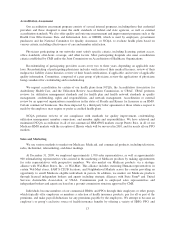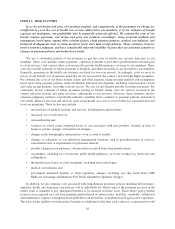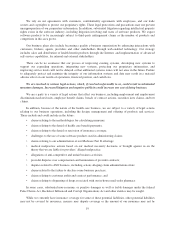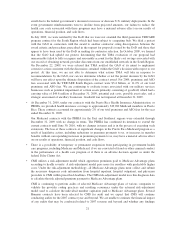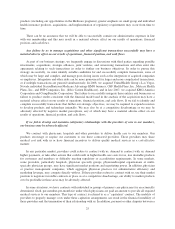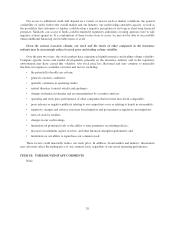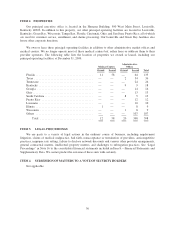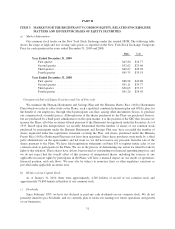Humana 2009 Annual Report Download - page 32
Download and view the complete annual report
Please find page 32 of the 2009 Humana annual report below. You can navigate through the pages in the report by either clicking on the pages listed below, or by using the keyword search tool below to find specific information within the annual report.would cause a change to our method of estimating future premium revenue in bid submissions made to
CMS for future contract years, or compromise premium rate assumptions made in our bids for prior
contract years. At this time, we do not know whether CMS will require payment adjustments to be made
using an audit methodology without comparison to original Medicare coding, and using its method of
extrapolating findings to the entire contract. However, if CMS requires payment adjustments to be made
using an audit methodology without comparison to original Medicare coding, and using a method of
extrapolating findings to the entire contract, and if we are unable to obtain any relief preventing the
payment adjustments from being implemented, we believe that such adjustments would have a material
adverse effect on our results of operations, financial position, and cash flows.
• The President of the United States and members of the U.S. Congress have proposed significant reforms
to the U.S. health care system. In November 2009, the U.S. House of Representatives passed the
Affordable Health Care for America Act and in December 2009 the U.S. Senate passed The Patient
Protection and Affordable Care Act, which we refer to collectively as the “Acts”. While there are
significant differences between the two Acts, they include, for example, limiting Medicare Advantage
payment rates, mandatory issuance of insurance coverage, requirements that would limit the ability of
health plans and insurers to vary premiums based on assessments of underlying risk, stipulating annual
rebates to enrollees if the amount of premium revenues expended on medical costs falls below
prescribed ratios for group and individual health insurance coverage, and imposing new non-deductible
taxes on health insurers increasing in the aggregate from $2 billion to $10 billion annually over ten
years. In addition, certain members of Congress have proposed a single-payer health care system, a
government health insurance option to compete with private plans, and other expanded public health
care measures. Various health insurance reform proposals are also emerging at the state level.
Because of the unsettled nature of these initiatives and the numerous steps required to implement them,
we cannot predict what health insurance initiatives, if any, will be implemented at the federal or state
level, or the effect any future legislation or regulation will have on our business. However, legislative
changes, if enacted, may have a material adverse affect on our results of operations, including lowering
our Medicare payment rates and increasing our expenses associated with the non-deductible excise tax,
financial position, including goodwill recoverability, and cash flows.
• Our CMS contracts which cover members’ prescription drugs under Medicare Part D contain provisions
for risk sharing and payments for prescription drug costs for which we are not at risk. These provisions,
certain of which are described below, affect our ultimate payments from CMS.
The premiums from CMS are subject to risk corridor provisions which compare costs targeted in our
annual bids to actual prescription drug costs, limited to actual costs that would have been incurred under
the standard coverage as defined by CMS. Variances exceeding certain thresholds may result in CMS
making additional payments to us or require us to refund to CMS a portion of the premiums we received
(known as a “risk corridor”). We estimate and recognize an adjustment to premium revenues related to
the risk corridor payment settlement based upon pharmacy claims experience. The estimate of the
settlement associated with these risk corridor provisions requires us to consider factors that may not be
certain, including member eligibility differences with CMS. Beginning in 2008, the risk corridor
thresholds increased which means we bear more risk. Our estimate of the settlement associated with the
Medicare Part D risk corridor provisions was a net payable of $144.6 million at December 31, 2009.
Reinsurance and low-income cost subsidies represent payments from CMS in connection with the
Medicare Part D program for which we assume no risk. Reinsurance subsidies represent payments for
CMS’s portion of claims costs which exceed the member’s out-of-pocket threshold, or the catastrophic
coverage level. Low-income cost subsidies represent payments from CMS for all or a portion of the
deductible, the coinsurance and co-payment amounts above the out-of-pocket threshold for low-income
beneficiaries. Monthly prospective payments from CMS for reinsurance and low-income cost subsidies
are based on assumptions submitted with our annual bid. A reconciliation and settlement of CMS’s
prospective subsidies against actual prescription drug costs we paid is made after the end of the year.
22



